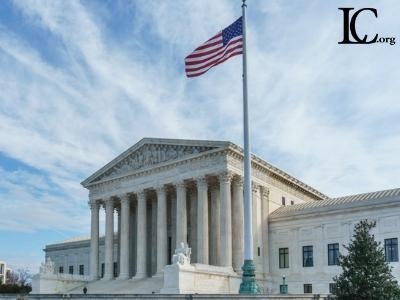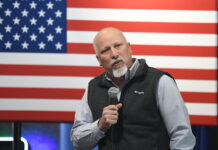As the U.S. Supreme Court concluded its recent term last June, the impact of decisions on the First Amendment Free Speech, Free Exercise of Religion, Establishment Clause, the Second Amendment, and the sanctity of human life will be felt for generations.
Free Speech, Free Exercise of Religion, and Establishment Clause
Shurtleff v. City of Boston
This historic Supreme Court Term began with Liberty Counsel’s case on May 2, 2022, when the Court issued its 9-0 opinion in Shurtleff v. City of Boston. The unanimous Court ruled that the City of Boston violated the First Amendment Free Speech Clause by censoring a private flag in a public forum open to “all applicants” merely because the application referred to it as a “Christian flag.” The High Court stated that the government admitted it censored the flag because it was referred to as a Christian flag on the application, that such censorship was viewpoint discrimination, and there was no Establishment Clause defense.
The Shurtleff case on May 2 set up the decision on the Coach Kennedy case on June 27 authored by Justice Gorsuch. In Shurtleff, Boston relied upon the 1971 case of Lemon v. Kurtzman to argue that the Establishment Clause required the city to censor religious viewpoints. Like Boston, the Bremerton School District also relied on the so-called Lemontest to argue it must censor the silent prayer of Coach Kennedy. In Shurtleff, the same flag could have flown IF Hal Shurtleff viewed it as secular. If he had referred to it as the Camp Constitution flag and not a Christian flag, Boston would have approved the application. In the Coach Kennedy case, IF Kennedy took a knee after to ponder secular thoughts, then his action would be permitted. But if his intention was a silent prayer, the district banned him.
In his concurring opinion in Shurtleff, joined by Justice Thomas, Justice Gorsuch wrote the following, which he later referred to in the Coach Kennedy case:
“Boston candidly admits that it refused to fly the petitioners’ flag while allowing a secular group to fly a strikingly similar banner. And the city admits it did so for one reason and one reason only: It thought displaying the petitioners’ flag would violate ‘the [C]onstitution’s [E]stablishment [C]lause.’ That decision led directly to this lawsuit, all the years of litigation that followed, and the city’s loss today. Not a single Member of the Court seeks to defend Boston’s view that a municipal policy allowing all groups to fly their flags, secular and religious alike, would offend the Establishment Clause.”
“How did the city get it so wrong? To be fair, at least some of the blame belongs here and traces back to Lemon v. Kurtzman, 403 U. S. 602 (1971). Issued during a ‘bygone era’ when this Court took a more freewheeling approach to interpreting legal texts, Food Marketing Institute v. Argus Leader Media, 588 U. S. ___, ___ (2019) (slip op., at 8), Lemon sought to devise a one-size-fits-all test for resolving Establishment Clause disputes. That project bypassed any inquiry into the Clause’s original meaning. It ignored longstanding precedents. And instead of bringing clarity to the area, Lemon produced only chaos. In time, this Court came to recognize these problems, abandoned Lemon, and returned to a more humble jurisprudence centered on the Constitution’s original meaning. Yet in this case, the city chose to follow Lemon anyway. It proved a costly decision, and Boston’s travails supply a cautionary tale for other localities and lower courts.”
In memorable fashion, Justice Gorsuch continued to set forth the problems with Lemon:
“Ultimately, Lemon devolved into a kind of children’s game. Start with a Christmas scene, a menorah, or a flag. Then pick your own ‘reasonable observer’ avatar. In this game, the avatar’s default settings are lazy, uninformed about history, and not particularly inclined to legal research. His default mood is irritable. To play, expose your avatar to the display and ask for his reaction. How does he feel about it? Mind you: Don’t ask him whether the proposed display actually amounts to an establishment of religion. Just ask him if he feels it ‘endorses’ religion. If so, game over.”
“Faced with such a malleable test, risk-averse local officials found themselves in an ironic bind. To avoid Establishment Clause liability, they sometimes felt they had to discriminate against religious speech and suppress religious exercises. But those actions, in turn, only invited liability under other provisions of the First Amendment. The hard truth is, Lemon’sabstract and ahistoric test put ‘[p]olicymakers . . . in a vise between the Establishment Clause on one side and the Free Speech and Free Exercise Clauses on the other.’ Pinette, 515 U. S., at 767–768 (plurality opinion).”
“Our case illustrates the problem. The flags of many nations bear religious symbols. So do the flags of various private groups. Historically, Boston has allowed them all. The city has even flown a flag with a cross nearly identical in size to the one on petitioners’ flag. It was a banner presented by a secular group to commemorate the Battle of Bunker Hill. See Appendix, infra (photographs). Yet when petitioners offered their flag, the city flinched. . . . To avoid a spurious First Amendment problem, Boston wound up inviting a real one.”
“While it is easy to see how Lemon led to a strange world in which local governments have sometimes violated the First Amendment in the name of protecting it, less clear is why this state of affairs still persists. Lemon has long since been exposed as an anomaly and a mistake. From the birth of modern Establishment Clause litigation in Everson v. Board of Ed. of Ewing, this Court looked primarily to historical practices and analogues to guide its analysis. 330 U. S. 1, 9–15 (1947).”
“Lemon interrupted this long line of precedents. It offered no plausible reason for ignoring their teachings. And, as we have seen, the ahistoric alternative it offered quickly proved both unworkable in practice and unsound in its results. Nor is it as if Lemon vanquished the field even during its heyday. Often, this Court continued to look to history to resolve certain Establishment Clause disputes outside the context of religious displays. And several early decisions applying Lemon were themselves rapidly overruled in part or in whole.8All of which in time led Justice after Justice to conclude that Lemon was ‘flawed in its fundamentals,’ ‘unworkable in practice,’ and “inconsistent with our history and our precedents.” County of Allegheny, 492 U. S., at 655,
669 (Kennedy, J., concurring in judgment in part and dissenting in part).
When Justice Gorsuch wrote his concurrence in Shurtleff, the Coach Kennedy case was already argued, the Justices had voted, and Gorsuch was in the process of drafting the Kennedy opinion. The conclusion of his concurrence in Shurtleff, laid the foundation for his majority opinion in Kennedy. He wrote:
“To justify a policy that discriminated against religion, Boston sought to drag Lemon once more from its grave. It was a strategy as risky as it was unsound. Lemon ignored the original meaning of the Establishment Clause, it disregarded mountains of precedent, and it substituted a serious constitutional inquiry with a guessing game. This Court long ago interred Lemon, and it is past time for local officials and lower courts to let it lie.”
Kennedy v. Bremerton School District
The Supreme Court resolved its final religious freedom and free speech case of the term on June 27, 2022, in Kennedy v. Bremerton School District. The Justices ruled 6-3 in favor of a high school football coach who was fired for silently praying on the field after games. Like in Liberty Counsel’s Shurtleff case, the government argued that what otherwise appears to be private speech is government speech. Relying on both the First Amendment Free Speech and Free Exercise Clauses, the High Court ruled that the Bremerton School District violated both provisions when it fired Coach Joe Kennedy for having prayer on the 50-yard line of the football field after the game. And building on the Shurtleff case, the Kennedy case put the final nail in the coffin of the 51-year-old Lemontest.
Justice Neil Gorsuch wrote in the majority opinion, “This case looks very different from those in which this court has found prayer involving public school students to be problematically coercive,” he said. “The prayers for which Mr. Kennedy was disciplined were not publicly broadcast or recited to a captive audience. Students were not required or expected to participate.”
The Court also finally buried the court-made Lemon test, citing the 9-0 Shurtleff decision involving the Christian flag. The Justices referred to the Lemon Test in that opinion. The Court wrote, “In fact, just this Term the Court unanimously rejected a city’s attempt to censor religious speech based on Lemon and the endorsement test (See Shurtleff, 596 U. S.).”
The Supreme Court says it “long ago abandoned Lemon and its endorsement test offshoot.” Instead of Lemon, the Supreme Court “has instructed that the Establishment Clause must be interpreted by ‘reference to historical practices and understandings.’”
The High Court further concluded, “The Constitution and the best of our traditions counsel mutual respect and tolerance, not censorship and suppression, for religious and nonreligious views alike.”
Carson v. Makin
On June 21, the High Court ruled 6-3 in favor of religious freedom and school choice involving private religious schools.
Carson v. Makin challenged a Maine law that discriminates against parents based on religion by providing some families with tuition support for the school of their choice but denying that same support to other families. The High Court held that the Maine program violated the Free Exercise Clause.
Chief Justice John Roberts wrote the opinion and stated,
“A neutral benefit program that gives public funds to religious organizations through the independent choices of the recipients of those benefits does not violate the Constitution’s establishment clause. The principles outlined in two recent cases, Trinity Lutheran v. Comer and Espinoza v. Montana Department of Revenue, decide this case. Because the benefits hinge on whether a school is religious, the Maine program ‘effectively penalizes the free exercise’ of religion…The state pays tuition for certain students at private schools — so long as the schools are not religious. That is discrimination against religion.”
Abortion and the Rule of Law
Dobbs v. Jackson Women’s Health Organization
On June 24, 2022, the Supreme Court Dobbs v. Jackson Women’s Health Organization,voted 5-4 to overturn the 1973 Roe v. Wade and 1992 Planned Parenthood of Southeastern Pennsylvania v. Casey abortion decisions.
Justice Alito authored the 79-page opinion in which he wrote,
“Roe was egregiously wrong from the start. We hold that Roe and Casey must be overruled. It is time to heed the Constitution and return the issue of abortion to the people’s elected representatives…The Constitution makes no reference to abortion, and no such right is implicitly protected by any constitutional provision, including the one on which the defenders of Roe and Casey now chiefly rely.”
In 2018, Mississippi enacted the Gestational Age Act, which prohibited abortions after 15 weeks of gestation except in cases of medical emergency or severe fetal abnormality. Liberty Counsel submitted an amicus brief on behalf of a diverse group of organizations, churches, religious leaders, and individuals, including 70,000 African American and Hispanic churches and millions of African Americans and Hispanic. The brief overviews the racist, eugenic history and purpose of abortion to eliminate what the founder of Planned Parenthood, Margaret Sanger, referred to as “undesirables,” which especially targeted Black and Hispanic populations. The Supreme Court cited to Liberty Counsel’s case in footnote 41, stating that “it is beyond dispute that Roe has had that demographic effect. A highly disproportionate percentage of aborted fetuses are Black.”
Justice Thomas wrote separately to reiterate his view that the Due Process Clause also does not protect a right to an abortion.
“As I have previously explained, ‘substantive due process’ is an oxymoron that lacks any basis in the Constitution.” Indeed, “[t]he notion that a constitutional provision that guarantees only process before a person is deprived of life, liberty, or property could define the substance of those rights strains credulity for even the most causal user of words….“The resolution of this case is thus straightforward. Because the Due Process Clause does not secure any substantive rights, it does not secure a right to abortion.”
As a result, now the issue of abortion goes back to the states, many of which already had trigger laws banning abortion in place anticipating the overturning of Roe and Casey.
Justice Thomas also alluded to the fact that the High Court needs to revisit the 2015 Obergefell v. Hodges same-sex marriage case that appears to be hanging by a judicial thread. Justice Thomas wrote that the Court should “reconsider all of this Court’s substantive due process precedents, including Griswold, Lawrence, and Obergefell.”
Liberty Counsel Founder and Chairman Mat Staver, “Since the founding of Liberty Counsel in 1989, my mission has been to strengthen the Free Speech and Free Exercise Clauses, free the Establishment Clause from the judge-made Lemon test, and overturn the dreadful abortion decisions. All of this was accomplished between May 2 and June 27, 2022. For too many decades, the Supreme Court untethered itself from the Constitution. The High Court is finally issuing decisions that interpret the Constitution rather than impose its will upon the people. While this was an historic term, the fight for life and liberty must always continue. Freedom is always only one generation away for extinction.”
















